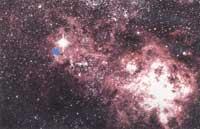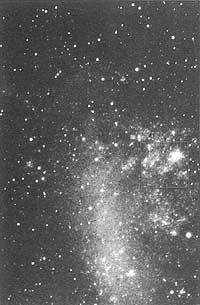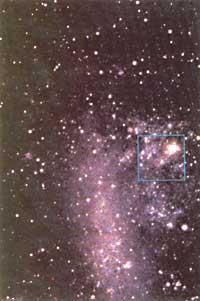5th Anniversary Supernova SN987A (II)
1992/09/01 Arregi Bengoa, Jesus Iturria: Elhuyar aldizkaria
In the next issue we finish with the appearance of the ring that surrounds the supernova. Now we will continue with the same ring, because thanks to it we have been able to calculate exactly the distance from the Earth to the supernova. The Hubble Space Telescope was not the only analysis. Before, a few weeks after the explosion, the satellite International Ultraviolet Explorer (IVE) collected the spectral lines of ultraviolet emitted by the ring. The emission was a consequence of the excitation caused by the radiation caused by the explosion and the study of the lines showed that it did not come from the gas clouds launched by the supernova, but from the still gas in the area. When it was found that this gas was the ring mentioned, the observations made through the two spacecraft could be compared to calculate the distance to which we have referenced.
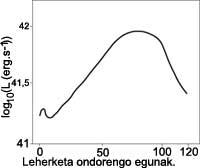
IVE measured ring diameter with a result of 1.36 light years. The Hubble Telescope measured the arch that occupies the ring, this being 1.66”. In order for the diameter value to measure the indicated arc, the ring must be 170,000 light-years. Indirectly, a very reliable value is obtained from the distance to the Great Cloud (up to LMV) of Magellan. This data had already been calculated from the clarity of the CML stars (mainly cefeid). The value obtained by this method was somewhat lower, 160,000 light years. We know, therefore, that the distances that this last method gives us must be corrected, since they must be somewhat greater.
Let us now analyze the brightness curve of SN1987 A. Normally, the brightness of the first days of the supernova is based on the shock wave caused by the explosion of the stars. This wave heats and expands the outer layer of the star. As for brightness, diffusion has two opposite effects. On the one hand, it reduces the temperature by decreasing the emission intensity and changing the color of the star from blue to reddish. On the other hand, it considerably increases the surface being emitted and also makes the star more diffuse by facilitating the radiation leakage. These last two effects are initially more effective and the intensity increases considerably until reaching the maximum brightness.
Our supernova, however, has some anomalies in these first steps. In the first seven days since its creation clarity weakened. Subsequently, it was strengthened especially slowly, without linking the maximum until June 3, the centenary day of the life of the supernova. Likewise, the maximum brightness was much lower than expected, despite exceeding 250 million times the brightness of the Sun. The calculations reveal the need for another energy source that heated the emitting layers from the forties. Otherwise, the cooling effect of the expansion could be imposed causing a decline. Let's see what explanations we have for these problems. (Figure 1 shows the evolution of the first 120 days of supernova brightness).
The initial ultraviolet flash has no clear explanation. The slowness of the subsequent climb and the low value of the maximum are explained by the nature of the star that we presented in the previous number. Once the upper layers are lost, the star is smaller and more compact. Therefore, most of the shock wave energy is needed to expand the star and make the diffuse enough for the light to be ejected. Consequently, the energy to heat the star is reduced.
Regarding the new energy source, we must undoubtedly find the answer in radioactive elements. The enormous temperature and pressure exerted by the shock wave causes numerous fusion reactions of light elements, among which are those that produce the radioactive element Ni56. Nickel 56 disintegrates with Cobalt 56. Its half-life is barely 6.1 days, that is, the nickel mass that formed, about 0.7 of the mass of the Sun, disappeared rapidly. The Co56 disintegrates with rays and Fe56, but with a duration of 77 days of average life. (Iron 56 is a normal iron, i.e. stable).
In fact, from day 120 the decrease in the brightness of the supernova occurs with the same period. Therefore, the radioactive elements mentioned have maintained the brightness of the supernova. The process is that the electrons found in the expanding gas disperse the gamma rays generated in disintegration, avoiding energy and thus transforming them into X-ray frequencies. Of course, that lost energy is the one that warms the gas. The correct affirmation of this process came back to us through satellites: In December 1987, the Solar Maximun Mission (SMM) received gamma rays of adequate frequency. Previously the SMM itself, the Japanese satellite Ginga and the Soviet Mir had received X-rays.
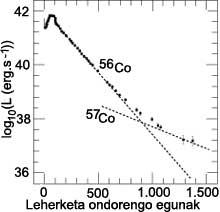
As can be seen in Figure 2, for a couple of years the decrease in emissions depended on the disintegration ratio of Co56 to the exhaustion of the element. Then the Co57 seems to be responsible for the brightness of the supernova. This cobalt isotope was created less, but has a longer half-life. Therefore, it lasts longer. However, until now the Co57 spectral line has not been detected. If this energy source was not confirmed, another alternative would be the neutron star that could generate the supernova.
At present, the brightness of the supernova is just one hundred times greater than that of the Sun, as one percent of the brightness of the star before it burst. If it weakens deeper, astronomers will have trouble studying further, as the other two stars next to them will be completely covered. We can already say that the supernova is dead and attention has been focused on the shock wave effects on the matter surrounding the supernova. In mid-1990, for example, the first radio waves were collected after the explosion in the vicinity of the superun. By 2000 the wave will reach the aforementioned ring. Apparently, it will be a surprising spectacle and the broadcast will be violent not only in visible light, but also in the field of X-rays and radio waves.
As can be seen, all the information obtained so far refers to the layers and media located on the outside of the supernova, since the inner layers are still opaque for all types of radiation and therefore do not allow the release of radiation from the nucleus. We do not know if the neutron star or the black hole has formed. The data obtained are favorable to the neutron star hypothesis, but it would be possible that the expanding gas initially remained under the neutron star's gravity field, subsequently falling. It is estimated that an hour later a tenth of the mass of the Sun could fall. Therefore, depending on the mass and initial state of the neutron star could become a black hole.
To get to the transparency and know what is at the core of the supernova, you cannot predict how long it will take, but it can be many years. There are calculations that indicate that it will take about 300 years, but as we said before it is very dangerous to get ahead of this problem.
September Anniversaries SUN: on September 22 at 18 h 42 min (UT) is put in Libra. Autumn begins.
PLANETS
|

Gai honi buruzko eduki gehiago
Elhuyarrek garatutako teknologia




